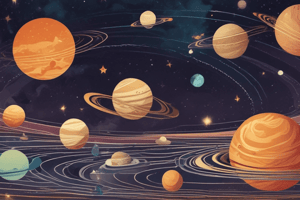Podcast
Questions and Answers
Based on the information, which of the following statements is TRUE about planetary bodies in our Solar System?
Based on the information, which of the following statements is TRUE about planetary bodies in our Solar System?
- The Oort Cloud, located beyond Neptune, is the source of most long-period comets, predominantly composed of ice. (correct)
- Comets orbit the Sun and are composed of dust, rock, and ice.
- Venus and Mercury have longer years than Earth due to their closer proximity to the Sun.
- The Kuiper Belt is located between Mars and Jupiter, consisting of mostly rocky objects.
Which of the following statements is NOT supported by the provided information?
Which of the following statements is NOT supported by the provided information?
- The Moon's orbit around the Earth takes approximately 27 days.
- The Andromeda Galaxy, the closest major galaxy to the Milky Way, is a barred spiral galaxy located about 2.5 million light-years away.
- The Sun is the dominant source of mass in the Solar System, accounting for 98.8% of its total mass.
- The Sun's light takes about 30 minutes to reach Earth, traveling at a speed of 300,000 km per second. (correct)
Based on the provided information, which of the following statements is INCORRECT about the Earth?
Based on the provided information, which of the following statements is INCORRECT about the Earth?
- The Earth spins from West to East.
- The distance between the Earth and the Sun is approximately 150 million kilometers.
- The Earth's atmosphere primarily comprises nitrogen and oxygen, with approximately 21% nitrogen and 78% oxygen. (correct)
- The Earth's atmosphere is composed predominantly of nitrogen and oxygen, with approximately 78% nitrogen and 21% oxygen.
Which of the following is NOT a direct consequence of a supernova, based on the information provided?
Which of the following is NOT a direct consequence of a supernova, based on the information provided?
Which of the following pairs is INCORRECTLY matched based on the provided description?
Which of the following pairs is INCORRECTLY matched based on the provided description?
What is the primary distinction between a refractor telescope and a reflector telescope, based on the information provided?
What is the primary distinction between a refractor telescope and a reflector telescope, based on the information provided?
According to the provided information, which of the following statements is TRUE about the Sun?
According to the provided information, which of the following statements is TRUE about the Sun?
Which of the following statements is CORRECT based on the provided information about the Solar System?
Which of the following statements is CORRECT based on the provided information about the Solar System?
Based on the provided information, which of the following statements describes the relationship between the Sun and Earth?
Based on the provided information, which of the following statements describes the relationship between the Sun and Earth?
Flashcards
Asteroid Belt
Asteroid Belt
A region with rocky objects located between Mars and Jupiter.
Kuiper Belt
Kuiper Belt
A region beyond Neptune filled with icy bodies.
Oort Cloud
Oort Cloud
A spherical region of icy comet nuclei, farthest from the Sun.
Ganymede
Ganymede
Signup and view all the flashcards
Venus and Mercury
Venus and Mercury
Signup and view all the flashcards
Supernova
Supernova
Signup and view all the flashcards
Core-collapse Supernova
Core-collapse Supernova
Signup and view all the flashcards
Earth's Atmosphere
Earth's Atmosphere
Signup and view all the flashcards
Light from the Sun to Earth
Light from the Sun to Earth
Signup and view all the flashcards
Moon Phases
Moon Phases
Signup and view all the flashcards
Study Notes
Solar System
- The Asteroid Belt is located between Mars and Jupiter, primarily containing rocky objects.
- The Kuiper Belt, beyond Neptune's orbit, is composed mainly of icy bodies.
- The Oort Cloud, the outermost region, is a spherical cloud of icy comet nuclei, the source of most long-period comets.
- Comets are made of dust, rock, and ice.
- The Solar System's largest moon, Ganymede, orbits Jupiter.
- The Sun is approximately 4.5 billion years old and comprises about 98.8% of the Solar System's mass.
- Venus and Mercury, closer to the Sun than Earth, have shorter orbital periods and are the roundest planets in the solar system (nearly perfect spheres).
- Mars hosts the largest volcano in the Solar System.
- All planets (excluding Earth) are named after Greek and Roman deities.
Astronomy
- Telescopes are categorized into refractor and reflector types.
- Apollo 11 was the first mission to land on the moon.
- A supernova, a massive stellar explosion, can result in neutron stars or black holes.
- Core-collapse supernovae occur in the final stages of massive stars (at least eight times the Sun's mass).
- Thermal runaway supernovae are another type of stellar explosion.
- No probe has yet landed on Jupiter or Saturn.
- The Andromeda Galaxy, a barred spiral galaxy, is the nearest major galaxy to the Milky Way, approximately 2.5 million light-years away.
Earth and the Moon
- Earth rotates from west to east and is 150 million kilometers from the Sun.
- Earth's atmosphere is roughly 78% nitrogen and 21% oxygen.
- Sunlight takes about 8 minutes to reach Earth (traveling at 300,000 km/s).
- Proxima Centauri is the closest star to Earth (besides the Sun).
- The Moon has no atmosphere, orbits Earth every 27 days, and reflects sunlight for visibility.
- There are 8 main phases in the Moon's cycle.
- A Blue Moon occurs when there are two full moons in a single calendar month (happens roughly every 2.7 years).
Studying That Suits You
Use AI to generate personalized quizzes and flashcards to suit your learning preferences.




